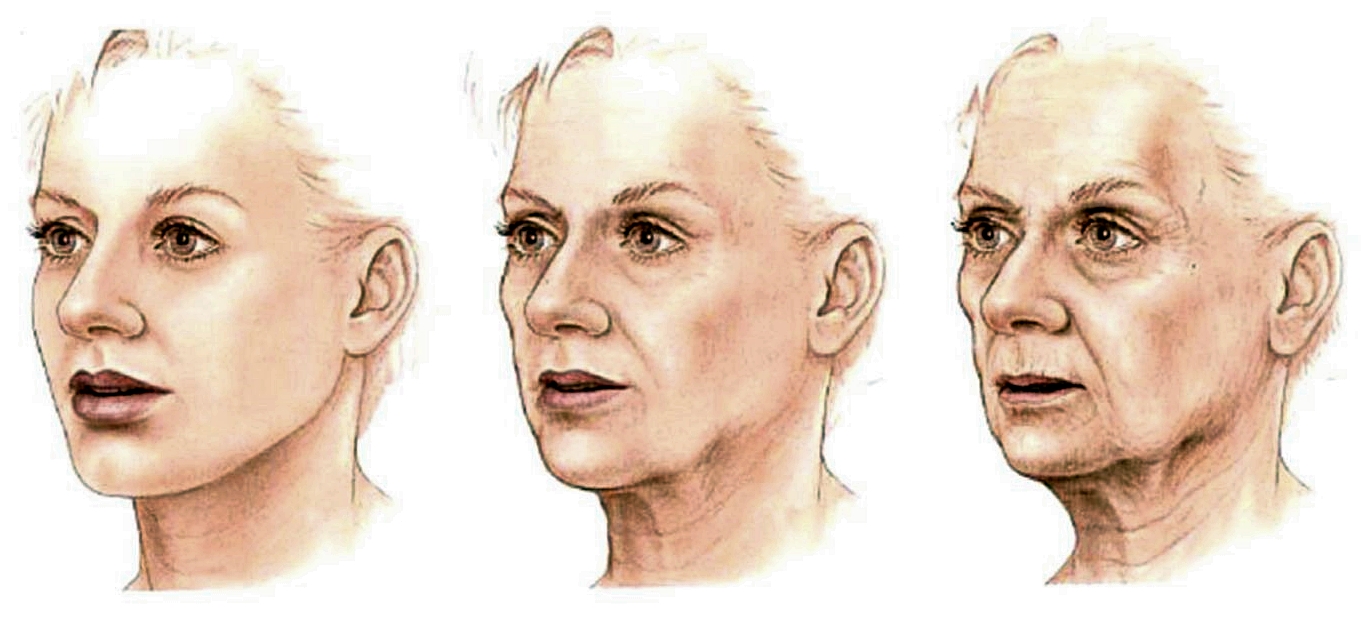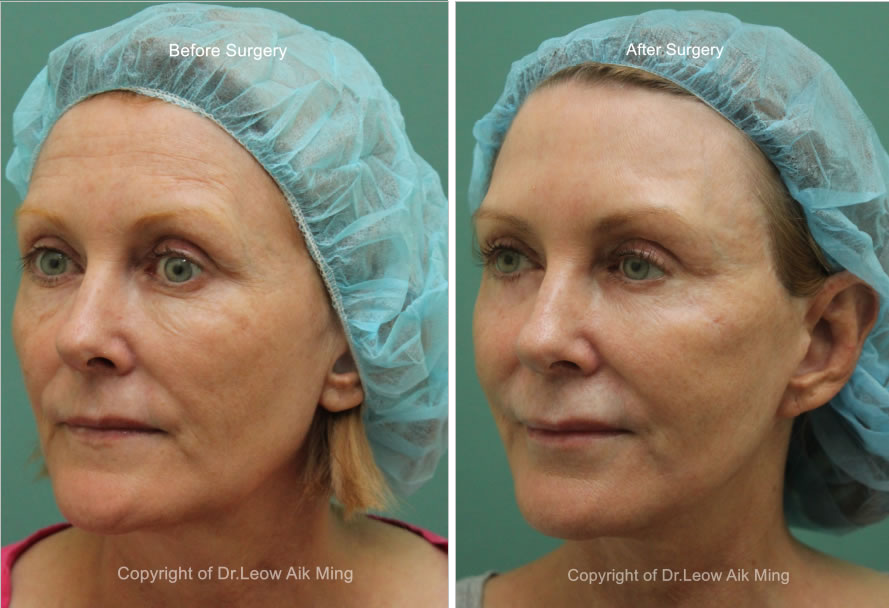Facial ageing reflects the dynamic, cumulative effects of time on the skin, soft tissues, and deep structural components of the face, and is a complex synergy of skin textural changes and loss of facial volume. Many of the facial manifestations of ageing reflect the combined effects of gravity, progressive facial bone resorption, decreased soft tissue elasticity, and redistribution of subcutaneous fullness.

Facelift, or rhytidectomy, is a cosmetic surgical procedure that improves visible signs of ageing in the face and neck. The aesthetic goal is to rejuvenate and enhance facial contours and overall appearance through the tightening of facial tissue and muscles, and the repositioning of skin. This helps remove wrinkles and droopiness from the eyes, face and neck, creating a more defined facial structure and overall rejuvenated appearance. It is important to aware that facelift does not stop the ageing process.
Most facelift techniques focus on the lower facial areas, such as the jawline, jowls and cheeks. A facelift can also focus on the midface or the forehead. In some techniques, deeper facial tissues may be repositioned or tightened to restore a more youthful contour. Today, many different methods such as traditional facelift, limited incision facelift or MACS (Minimal Access Cranial Suspension) facelift exist with outcomes that can be consistently reliable, safe, and durable. The selection of different types of facelift techniques will depend on the area of the face that is targeted and the number of desirable changes.
Other procedures that might be performed in conjunction with a facelift to achieve desirable aesthetic results are brow lift and eyelid surgery to rejuvenate ageing eyes or neck lift to improve the neck contour. Fat transfer or fillers may be suggested to replace the depleted fat volume in the face. Complementary treatments such as dermabrasion, peels or laser may be offered to improve the quality and texture of the skin.
Facelift surgery can only be performed surgically. Non-surgical rejuvenation treatments cannot achieve the same results as a facelift but may help delay the time at which a facelift becomes appropriate and complement the results of surgery. Some non-surgical treatments, such as stem cell facelifts, are of unproven benefit.
Ideal candidates for facelift surgery:
The best candidates for a facelift are men and women who are looking for an improvement in their appearance and have realistic expectations. A facelift can make a person looks younger and fresher. It may enhance self-esteem, but it won’t give a different look, nor can it restore health and vitality. Always remember that when a person decided to undergo any cosmetic surgery, it is for oneself and not for others. Always be ready for a recovery period of a few weeks if you want a long-lasting result.
Preoperative evaluation for facelift surgery
Communication is vital to achieving the patient’s goals. During the initial consultation, patients will have the opportunity to discuss their goals and desired results with the plastic surgeon. The plastic surgeon will work closely with the patients to reach an agreement about the expectations from the surgical procedures involved and their long term benefits. Every patient is different. Therefore a specific treatment regimen is planned to suit an individual’s need.
The preoperative assessment for facelift surgery may involve:
- Discussion about patients’ expectations and desired outcome
- Medical conditions, drug allergies and previous medical or surgical treatment
- Use of current medications, vitamins, herbal supplements, alcohol, tobacco and drugs
- Examination of the face and its soft tissues
- Discuss the options available for a facelift and facial rejuvenation
- Preoperative evaluation for types of anaesthesia
- Photography for preoperative and postoperative evaluation
Preparation for facelift surgery
- Preoperative medical evaluation including blood investigations
- Avoid certain medications or adjust your current medications
- Stop smoking or alcohol for about 2-3 weeks before the scheduled surgery
- Avoid taking aspirin and certain anti-inflammatory drugs and herbal supplements as they can increase bleeding and bruises
The risks and safety information on facelift surgery
It is crucial for patients to understand that every surgical procedure has its complications and downtime. However, if a patient is appropriately assessed before the surgery and postoperative care is given adequately, these risks can be eliminated or reduced. The risks involved in facelift surgery may vary depending upon the nature of the surgical procedure.
Some of the risks of facelift surgery include:
- Wound infection
- Poor wound healing (higher risks in chronic smokers)
- Unfavourable scarring
- Bleeding (hematoma)
- Anaesthesia risks
- Hair loss at the incisions
- Facial nerve injury resulting in facial muscle weakness
- Facial asymmetry
- Numbness or other changes in skin sensation
- Fat necrosis
- Fluid accumulation
- Skin contour irregularities
- Skin discolouration, sensitivity or swelling
- Possibility of revision surgery
Postoperative expectations for facelift surgery:
After surgery, the head and face will be loosely bandaged to help reduce swelling and bruising. Depending upon the situation, a drainage tube may be inserted behind the patient’s ear to prevent blood and fluid from collecting under the skin. Pain medication is usually prescribed to make the patient feel as comfortable as possible following surgery. During the facelift recovery, patients should allow for adequate healing time. Expect some postoperative swelling, numbness, and bruises for about 2-3 weeks. All incisions and dressings should be kept clean and dry. For the first few days, the head should be kept elevated and immobile to minimise swelling. Most of the stitches will be removed in about 5-7 days.
Strenuous exercise should be avoided for at least the initial two weeks after surgery. Alcohol or hot saunas should be avoided for several weeks. During the facelift recovery period, extra rest is critical to promote proper wound healing. The outcome of facelift results will be apparent gradually once the swelling and bruises resolved.
Case No.1:

Case No.2:
Postoperative care
- Follow the postoperative instructions given carefully
- Head elevation especially when sleeping for 1-2 weeks
- Take the prescribed medications as instructed
- A compressive bandage or facial garment may be used for 3-5 days
- Ice compression on the face for 3-5 days
- Regular wound cleaning with an antiseptic solution and antibiotic ointment
- Allow gentle hair washing from second-day post surgery
- Avoid strenuous physical activities for 3-4 weeks
- Makeup to cover the bruises and discolouration may be allowed from third-day post surgery
- Regular use of sunblock for 3-6 months after the surgery
How much will facelift surgery cost?
Cost is always a consideration in elective surgery. The cost for a facelift can vary widely. Cost may include:
- Surgeon’s fee
- Hospital or surgical facility costs
- Medical tests (blood investigations)
- Anaesthesia fees
- Prescriptions for medication
- Post-surgery garment (facial garment)
Facelift surgery is a cosmetic surgical procedure. Therefore, most of the health insurance companies do not cover cosmetic surgeries or their complications.
Postoperative care
- Follow the postoperative instructions given carefully
- Head elevation especially when sleeping for 1-2 weeks
- Take the prescribed medications as instructed
- A compressive bandage or facial garment may be used for 3-5 days
- Ice compression on the face for 3-5 days
- Regular wound cleaning with an antiseptic solution and antibiotic ointment
- Allow gentle hair washing from second-day post surgery
- Avoid strenuous physical activities for 3-4 weeks
- Makeup to cover the bruises and discolouration may be allowed from third-day post surgery
- Regular use of sunblock for 3-6 months after the surgery
How much will facelift surgery cost?
Cost is always a consideration in elective surgery. The cost for a facelift can vary widely. Cost may include:
- Surgeon’s fee
- Hospital or surgical facility costs
- Medical tests (blood investigations)
- Anaesthesia fees
- Prescriptions for medication
- Post-surgery garment (facial garment)
Facelift surgery is a cosmetic surgical procedure. Therefore, most of the health insurance companies do not cover cosmetic surgeries or their complications.
